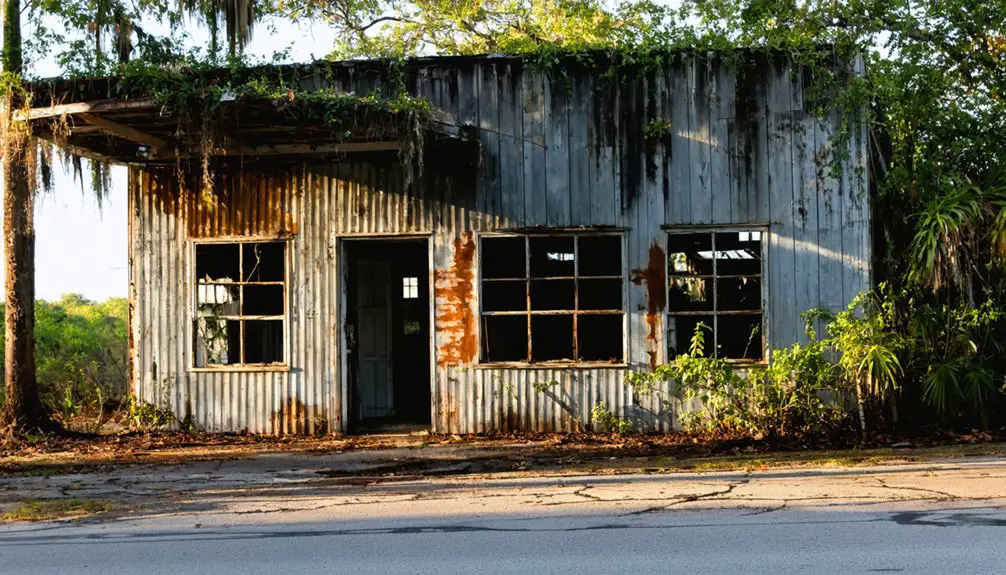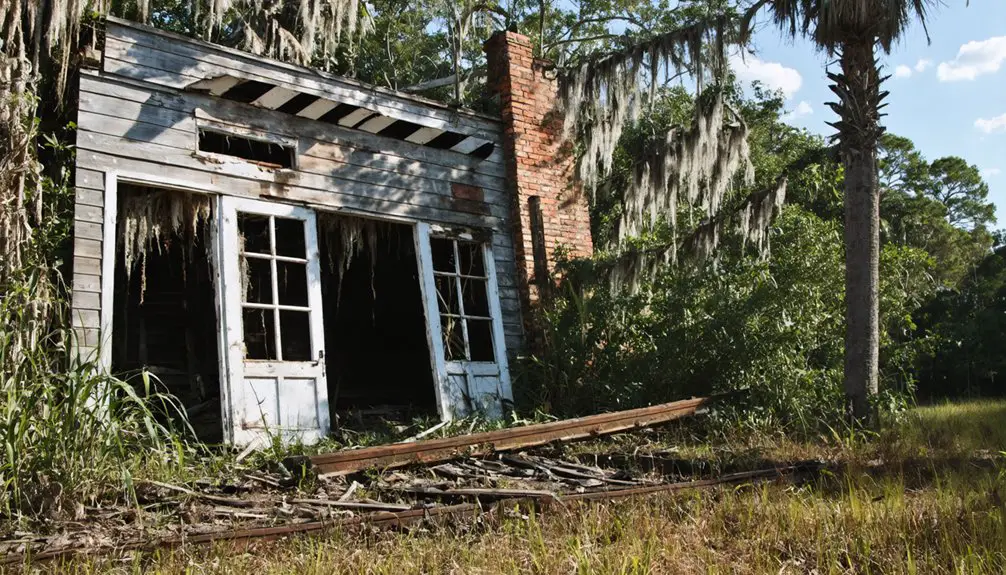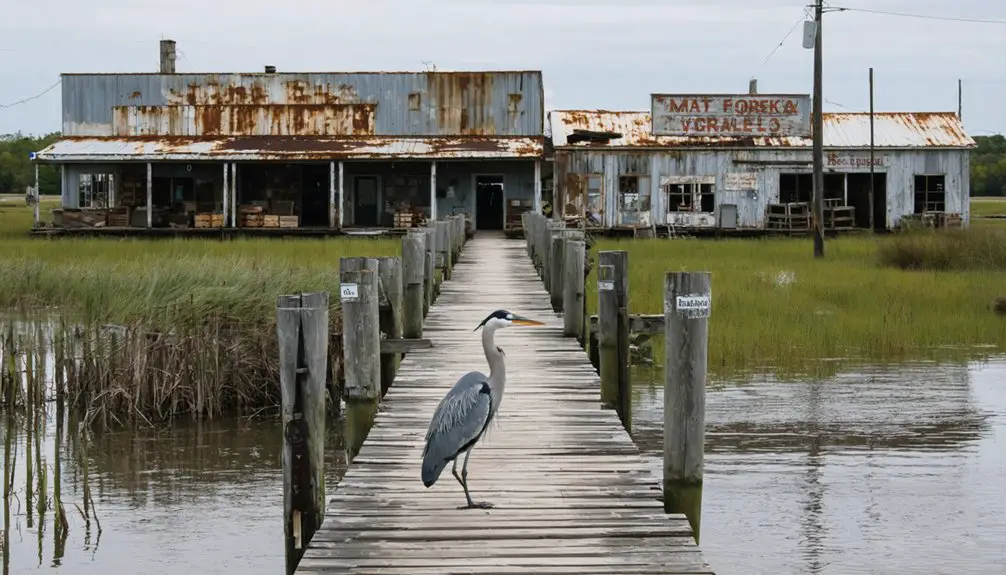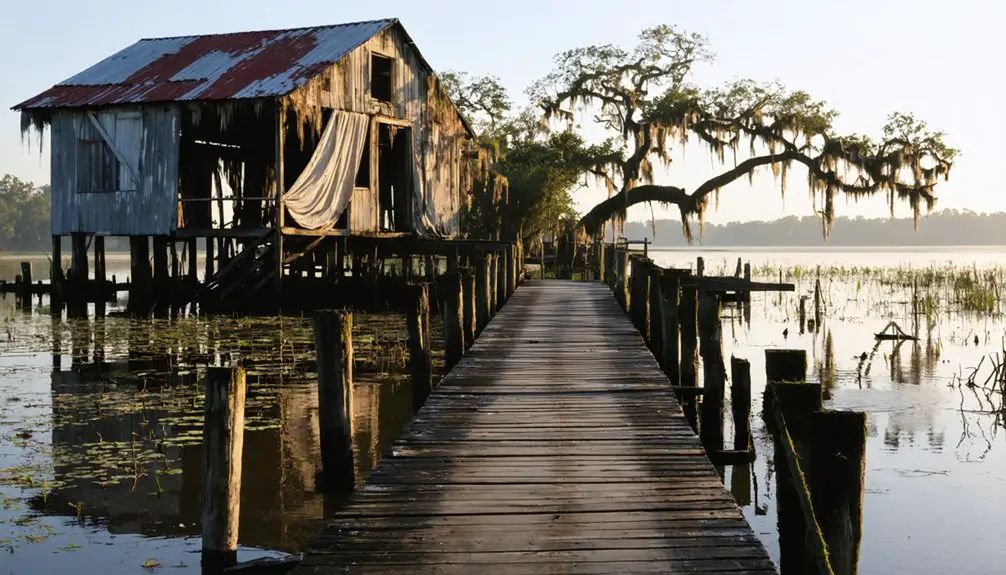You’ll find Quay’s haunting remains along Florida’s Indian River County coast, where a 1920s boomtown once dreamed of prosperity. The settlement, renamed from Woodley to honor Senator Matthew Quay, thrived briefly on logging and trade before falling victim to Florida’s real estate bust and the Great Depression. Today, only weathered headstones in Quay Cemetery and old dock pilings along Winter Beach Road whisper stories of this ambitious waterfront community’s rise and fall.
Key Takeaways
- Quay emerged during Florida’s 1920s real estate boom but transformed into a ghost town following economic collapse and the Great Depression.
- The settlement changed its name from Quay to Winter Beach in 1922, marking the end of ambitious development plans.
- Only Quay Cemetery remains as the last physical evidence of the former settlement’s existence in Indian River County.
- The community’s decline accelerated after losing the county seat bid to Vero Beach and the bursting of Florida’s land speculation bubble.
- Natural vegetation has reclaimed most of Quay’s former structures, with only traces of old dock pilings and abandoned rail corridors visible.
The Birth of Woodley and Its Transformation
While early settlers established farms and orange groves in the 1800s, Woodley’s true development began alongside the arrival of crucial transportation routes, particularly the railroad.
You’ll find that the settlement patterns reflected a mix of agricultural practices and industrial ventures, as the community thrived on logging, turpentine production, and mining. Early residents built relationships with Seminole Indians, establishing significant trade connections that supported the town’s growth. Similar to the Etna settlement, the area supported a thriving turpentine camp operation.
As railroads expanded through the region, you could see Woodley transform from a simple farming settlement into a bustling trade hub. Like many Florida communities, it experienced the typical boom-bust cycles that characterized development throughout the state.
The community’s lifeblood flowed through its orange groves and farms, while the surrounding forests provided abundant resources for the logging and turpentine industries, creating a diverse economic foundation that would define the town’s early years.
Senator Quay’s Legacy and Waterway Development
Beyond Woodley’s local developments, a powerful political figure would shape the region’s maritime future. Senator Matthew Quay‘s influence extended far beyond his Pennsylvania home state, leaving an indelible waterway legacy in Florida’s maritime infrastructure.
You’ll find his impact in the extensive network of protected channels that revolutionized coastal navigation. Through Quay’s advocacy, Florida secured essential federal backing and land grants exceeding a million acres for canal construction.
His vision helped establish standardized waterways – 50 feet wide and 5 feet deep – connecting Tampa Bay to Venice with strategic cuts through Clam Bar and The Mangroves. These sheltered passages allowed over 100 boat launches and freight lines to operate safely away from treacherous Gulf waters, transforming the region’s commerce and setting the foundation for Florida’s modern inland navigation system.
Winter Beach: A New Identity Emerges
You’ll recognize Winter Beach’s clever marketing strategy in its 1922 name change and slogan “Where Sunshine Spends the Winter,” which aimed to attract northern settlers to this ambitious 8,000-lot development.
By 1925, your growing community had even positioned itself as a contender for the Indian River County seat, though it ultimately lost to the incorporated Vero Beach.
The area saw some development after Representative Anthony Young introduced legislation to form Indian River County that same year. Your hopes for a thriving resort town faded when the 1929 economic depression halted development plans throughout Florida, leaving Winter Beach’s grand vision largely unrealized. The area still maintains the historic Winter Beach Cemetery, established in 1908 as one of the earliest landmarks in the community.
Marketing The New Name
As Florida’s land boom gained momentum in the early 1920s, the small community of Quay commenced a strategic rebranding effort to attract developers and seasonal residents.
The marketing strategies centered on transforming the town’s identity from one honoring Senator Matthew Quay to a more appealing destination called Winter Beach.
You’ll find the branding evolution reflected in the town’s carefully crafted slogan, “Where the Sunshine Spends the Winter,” which aimed to entice northerners seeking refuge from harsh winters.
Ambitious promotional campaigns advertised 8,000 residential lots stretching from the Indian River to the Atlantic Ocean. The marketing highlighted planned infrastructure improvements, including causeway access, and positioned Winter Beach as an exclusive coastal retreat. The area’s rich history is preserved in the Winter Beach Cemetery, established in 1908 as a testament to the community’s enduring legacy. The Quay Dock road remains one of the most scenic routes in the county, offering glimpses into the area’s historic past.
While the subsequent land bust dampened development plans, this rebranding permanently shaped the community’s identity.
Land Development Rush
When Winter Beach emerged as a promising development project in the early 1920s, local visionaries launched an ambitious plan to transform 8,000 lots of pristine coastal land into a thriving winter haven.
You’d find yourself swept up in the era’s land speculation fever, as developers marketed an irresistible package: direct access from the Indian River Lagoon to the Atlantic Ocean via a new causeway system.
The timing couldn’t have been better. With Indian River County‘s formation in 1925, seasonal tourism was booming. Just like the Town of Indian River Shores established decades later in 1953, the area was positioned for significant coastal growth.
You’d see infrastructure rapidly taking shape – new roads, bridges, and social amenities catering to affluent winter visitors. Today, the Winter Beach Historical Society continues to preserve these fascinating stories of early development. The development’s strategic location between the lagoon and ocean made it an attractive destination for those seeking both inland waterway access and beachfront living opportunities.
Hope Fades Away
Despite Senator Matthew S. Quay‘s early influence and the promise of his Senate bill to improve the Intracoastal Waterway, you’ll find that community optimism began fading by the mid-1920s.
When Indian River County chose Vero Beach over Winter Beach for its county seat in 1925, the town’s prospects dimmed considerably.
The community’s resilience showed through its strategic renaming from Quay to Winter Beach, adopting the hopeful slogan “Where the Sunshine Spends the Winter.”
Today’s population growth to over 3,100 residents shows some recovery from those challenging early days.
But you can trace how the railroad’s inland development drew residents away, while the Great Depression delivered the final blow to ambitious development plans.
The bridge tender’s home once stood as a vital link for the community, until the Winter Beach Bridge’s destruction after World War II left only scattered pilings as remnants of the past.
The jungle reclaimed abandoned settlements, and agricultural jobs disappeared.
Though Winter Beach preserved its pioneer heritage through local historical societies, it never achieved its dream of becoming the bustling town early settlers envisioned.
The Florida Land Boom’s False Promise

The Florida Land Boom of the 1920s lured countless Americans into a web of false promises and speculative frenzy.
Like moths to flame, Americans rushed headlong into Florida’s dazzling 1920s real estate mirage, their dreams fueled by promises of paradise.
You’d have seen thousands of your fellow citizens pouring their savings into speculative investments, buying plots they’d never visited based on glossy brochures and smooth-talking salesmen.
With unrealistic expectations fueled by media hype and easy credit, many dreamed of quick riches in a tropical paradise.
- Banks and developers worked hand-in-hand, driving land prices far beyond their true value.
- Mail-order land sales left buyers with worthless swamps and snake-infested marshes.
- Grand promises of roads, utilities, and new cities remained largely unfulfilled.
- Two devastating hurricanes in 1926 and 1928 delivered the final blow, leaving concrete foundations as ghostly reminders.
These empty promises shaped Florida’s landscape and left thousands financially ruined, serving as a stark warning about unchecked speculation.
Geographic Features and Natural Surroundings
Located at the intersection of US Highway 1 and Winter Beach Road in Indian River County, Quay’s natural landscape tells a story of Florida’s dynamic coastal environment.
You’ll find a flat, low-lying terrain where native vegetation wages a constant battle of geographic reclamation, with saw palmettos, scrub pines, and mangroves steadily consuming what humans once built.
The area’s position near the Intracoastal Waterway showcases rich coastal ecosystems, from wetlands to barrier islands.
Old dock pilings still peek through the water, while dense thickets typical of Florida’s east coast have overtaken abandoned structures.
The sandy soils near the shore give way to swampier ground inland, and the hot, humid climate accelerates nature’s persistent reclamation of this once-bustling settlement.
Historic Infrastructure and Lost Architecture

You’ll find few traces of Quay’s original structures today, as the buildings that once lined Main Street have long since vanished without a trace.
The town’s main transportation artery was renamed from Quay Road to Winter Beach Road in a 1920s attempt to attract more development.
When the road systems changed and bypassed the settlement, Quay’s remaining commercial buildings gradually disappeared, leaving behind only scattered hints of its former layout.
Transportation Routes Changed
During the late 19th century, Quay’s crucial transportation network centered around Quay Dock Road, a pioneering route constructed in the 1890s that connected John’s Island settlers to mainland markets. This essential lifeline supported early commerce until the transportation evolution brought dramatic changes.
As railroad realignments shifted economic priorities, particularly when the Atlantic Coast Line Railroad relocated its depot in the 1920s, Quay’s infrastructure declined.
- Wooden bridge remnants and old dock pilings still peek through the water, marking where vessels once loaded agricultural goods.
- The Florida East Coast Railway’s expansion redirected trade flows, diminishing Quay Dock Road’s significance.
- Original wagon routes fell into disuse as rail became the dominant transport mode.
- Nature has reclaimed many abandoned rail corridors, erasing traces of Quay’s once-bustling transport network.
Original Buildings Disappeared
While transportation changes marked Quay’s initial decline, the town’s physical disappearance tells an even more dramatic story.
You’ll find nearly all original structures have vanished, victims of nature’s relentless assault and human neglect. The architectural decay is extensive – only faint traces of brick roads and crumbling foundations remain where homes and businesses once stood.
Florida’s harsh coastal environment hasn’t been kind to Quay’s heritage. Hurricanes, wildfires, and persistent saltwater intrusion have torn away at wooden buildings and metal fixtures.
The few surviving structures, like the stilt houses, face serious preservation challenges. You’ll need special permits to access these fragile remnants, as they’re constantly battling against time and elements.
What’s left serves as a stark reminder of how quickly a thriving community can fade into history.
The Cemetery: A Window to the Past
Hidden beneath tangled vines and guarded by time, the Quay Cemetery stands as the final physical remnant of this once-vibrant Florida frontier settlement. Within its modest 30×30 foot fenced area, you’ll discover burial practices that tell the story of hardy pioneers who shaped this land in the late 1800s.
The cemetery’s symbolism runs deep through cracked headstones and family plots, offering glimpses into the community’s struggles and triumphs.
Weathered stones and family plots tell silent tales of life and loss in this pioneer community’s sacred ground.
- Weathered monuments of the McAtee family and others reveal kinship ties that bound the settlement
- Empty pedestals and fallen stones speak to the harsh realities of frontier life
- Children’s graves reflect the period’s high mortality rates
- Family plots showcase the tight-knit social fabric that defined Quay’s community
Economic Rise and Fall Through the Decades

As dreams of prosperity swept through Florida in the early 1900s, the small settlement of Woodley pinned its hopes on a strategic name change to Quay, honoring the influential Senator Matthew Quay who’d secured Congressional funding for the Indian River Lagoon’s dredging project.
You’ll find that economic trends in Quay mirrored Florida’s volatile 1920s land boom. Despite improved navigation through the newly dredged Intracoastal Waterway, the community’s growth remained stagnant.
When the speculative bubble burst, Quay’s prospects collapsed. The town’s final name change to Winter Beach couldn’t salvage its fate. Community resilience wasn’t enough to overcome the economic downturn, and development ground to a halt.
Today, only Quay Dock Road and the old cemetery stand as evidence to those ambitious early dreams of creating a thriving waterfront town.
Cultural Impact on Indian River County
You’ll find traces of Winter Beach’s cultural heritage in one of Indian River County’s oldest cemeteries, where generations of local families have been laid to rest since the early settlement days.
The evolution of the town’s identity from Woodley to Quay to Winter Beach mirrors the community’s efforts to adapt and grow with Florida’s changing economic landscape.
Historic road networks like Quay Dock Road, which once served as essential arteries for agricultural transport, continue to connect today’s residents with their pioneering past.
Cemetery Heritage Preservation
Despite the passage of time, Quay’s historic cemetery remains one of the most significant cultural touchstones in Indian River County, preserving the memories of early settlers who shaped the region.
The cemetery’s historical significance extends beyond its physical presence, serving as an essential link to understanding the area’s pioneer heritage and development patterns.
- You’ll find the cemetery nestled west of US 1 near Quay Dock Road, though accessing it requires traversing old dirt paths.
- Original headstones from the late 1800s tell stories of family lineages and the impact of events like the Great Freeze.
- Local historical societies work to document and map the site, placing geocaches to encourage visitor engagement.
- Cemetery restoration efforts face ongoing challenges from natural overgrowth and environmental conditions, yet the site’s undisturbed location has helped preserve its authenticity.
Historic Road Networks
The historic road networks of Quay tell a compelling story of Indian River County’s early development, with Quay Dock Road serving as one of the area’s original thoroughfares.
You’ll find evidence of transportation evolution in the old wooden bridge that once spanned the Intracoastal Waterway, connecting the mainland to essential shipping routes.
Road accessibility played an important role in shaping the community’s destiny, as US 1 and Winter Beach Road created a grid that supported local agriculture, fishing, and commerce.
These pathways weren’t just about moving goods – they served as cultural lifelines, connecting scattered populations along the lagoon.
While the roads couldn’t prevent Quay’s eventual decline, they’ve left an indelible mark on the landscape, revealing how early settlers envisioned their community’s growth through strategic transportation planning.
Local Identity Evolution
While Quay’s name changes reflect the broader aspirations of Indian River County’s early development, they also tell a deeper story of cultural transformation.
You’ll find a community that faced multiple identity crises – from Woodley to Quay to Winter Beach – each shift marking pivotal moments in local history. Through economic ups and downs, the area’s community resilience shines in its ability to adapt while preserving its rich heritage.
- Senator Quay’s influence remains visible through historic Quay Dock Road and the lasting impact of Indian River Lagoon improvements.
- The cemetery stands as one of the county’s oldest landmarks, connecting present-day residents to their pioneering past.
- Early military and settler histories blend with indigenous heritage at the former fort site.
- Local heritage societies keep the ghost town’s memory alive through careful preservation of records.
Modern Day Remnants and Historical Preservation
Modern visitors to Winter Beach – formerly known as Quay – won’t find many traces of the once-promising Florida town, save for a historic cemetery and the aptly named Quay Dock Road.
Unlike other Florida ghost towns with preserved ruins and tourist infrastructure, Quay’s historical significance lives on primarily through community awareness and local writings.
While the Sebastian River Area Chamber of Commerce keeps the area’s heritage alive through historical references, you’ll find no formal museums or visitor centers dedicated to Quay’s past.
The cemetery, with its early 20th-century gravestones, serves as the most tangible link to the original settlement.
The surrounding landscape has transformed into a mix of rural and residential areas, with nature reclaiming much of what was once envisioned as a bustling Florida boom town.
Frequently Asked Questions
Are There Any Known Photographs of Original Buildings From Quay?
While you might hope to find historical documentation of Quay’s original structures, there aren’t any known photographs of the buildings. The lack of building preservation and complete disappearance of original structures has erased this visual history.
What Was the Population of Quay During Its Peak Years?
You won’t find exact Quay demographics in historical records, but based on comparable Florida ghost towns of that era, the peak population likely ranged between 50-200 residents during its heyday.
Did Any Famous People Besides Senator Quay Have Connections to the Town?
You’d think a town named after a senator would attract other historical figures, but ironically, no other celebrity connections emerged. Even local entrepreneurs who shaped nearby communities skipped over this modest settlement.
Were There Any Significant Archaeological Discoveries Made in the Quay Area?
You’ll find significant archaeological findings in the area, including 16th-century Spanish artifacts like crossbow bolts and chainmail. Historical artifacts from both indigenous peoples and early European contact periods have been discovered nearby.
What Industries or Businesses Operated in Quay Before Its Decline?
While you’d expect a booming town, Quay’s main enterprises were modest: small-scale timber operations in the pine forests, basic general stores, and transportation services supporting the Indian River’s dredged waterways.
References
- https://www.clickorlando.com/features/2024/09/25/floridas-creepiest-ghost-town-is-stashed-on-an-island-heres-the-lowdown/
- https://www.youtube.com/watch?v=6KjLHSm0GbA
- https://www.journaloffloridastudies.org/0102ghosttowns.html
- https://patchproflorida.com/blog/the-fascinating-history-of-floridas-ghost-towns/
- https://www.ghosttowns.com/states/fl/quay.html
- https://floridatrailblazer.com/category/ghost-towns/page/2/
- https://www.youtube.com/watch?v=lKufguzO19k
- https://www.youtube.com/watch?v=F-1EU-SqySs
- https://cccourthouse.org/wp-content/uploads/2023/12/Ghost-towns-and-Cemeteries-of-Citrus-County.pdf
- https://sarasota.wateratlas.usf.edu/upload/documents/03HistoricalDevelopment.pdf



